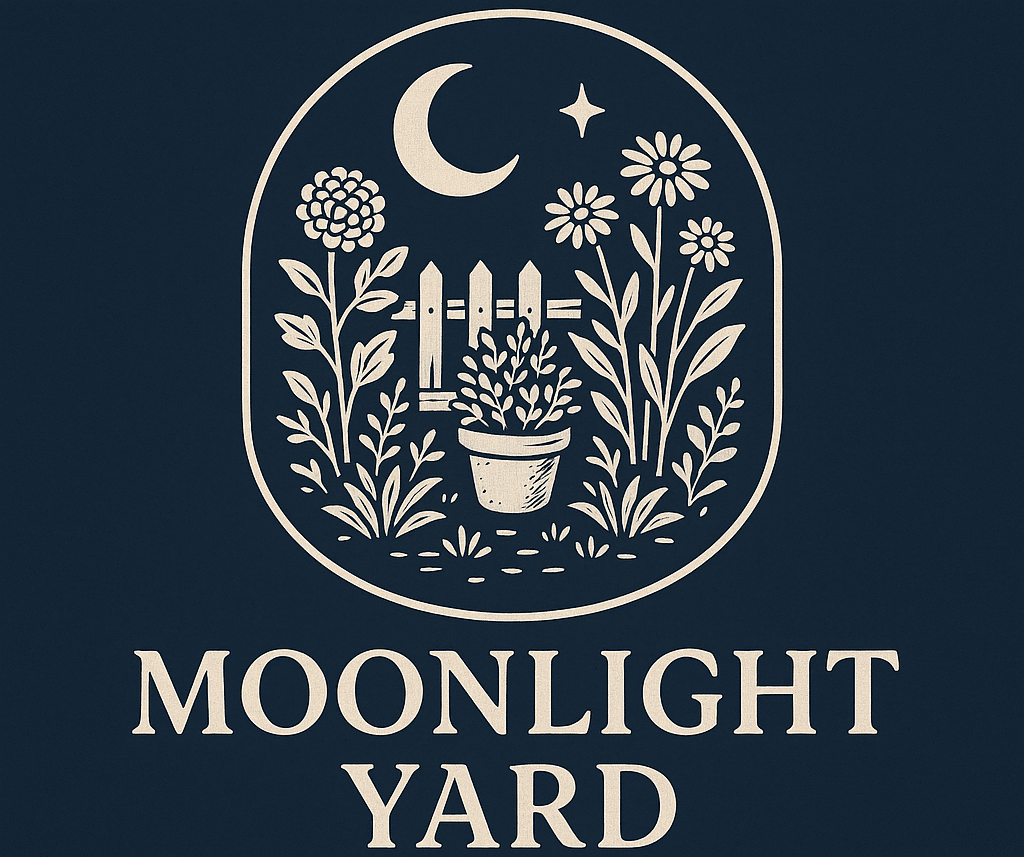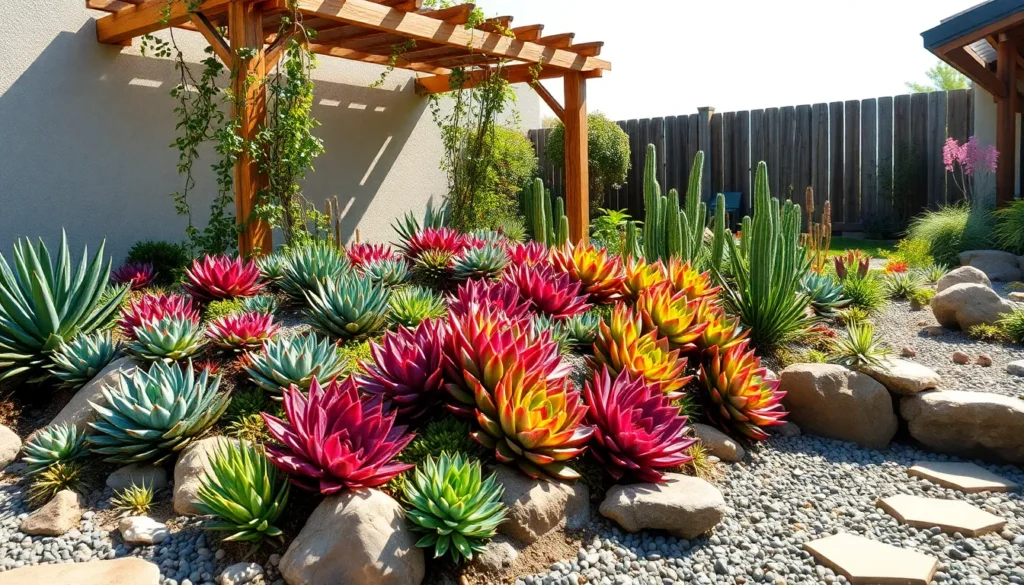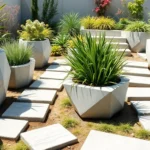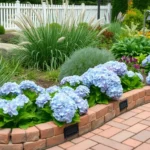We’ve all admired those stunning succulent arrangements that seem to thrive effortlessly while adding natural beauty to any space. These drought-tolerant plants aren’t just Instagram-worthy – they’re perfect for busy gardeners who want maximum impact with minimal maintenance.
Creating your own succulent garden opens up endless possibilities for creative expression. Whether you’re working with a sprawling backyard, a cozy balcony, or just a sunny windowsill, there’s a succulent arrangement that’ll transform your space into a desert oasis.
From vertical living walls to miniature fairy gardens, we’ll explore innovative ways to showcase these resilient beauties. You’ll discover how different textures, colors, and growth patterns can create visual interest that changes throughout the seasons. Ready to jump into the industry of succulent gardening? Let’s turn your green thumb dreams into reality with ideas that’ll make your neighbors wonder how you became such a gardening guru.
Choose the Perfect Location for Your Succulent Garden
Selecting the right spot for your succulent garden determines whether your plants will thrive or merely survive. We’ll guide you through the essential factors that make locations ideal for these remarkable plants.
Consider Sunlight Requirements
Succulents crave bright light but need protection from intense afternoon sun in hot climates. Most varieties flourish with 6 to 8 hours of morning sunlight and filtered light during peak afternoon hours. East facing locations provide gentle morning rays without scorching heat, while south facing spots work well in cooler regions.
Different succulent species have varying light needs that we must consider. Echeveria and Sedum varieties prefer full sun exposure, while Haworthia and Gasteria thrive in partial shade conditions. Observe how shadows move across potential garden sites throughout the day to identify the best lighting patterns.
Indoor succulent gardens need placement near bright windows or under grow lights. South facing windows offer the most consistent light, though sheer curtains help prevent leaf burn during summer months. We recommend rotating plants weekly to ensure even growth and prevent stretching toward light sources.
Evaluate Drainage Conditions
Perfect drainage stands as the most critical factor for succulent garden success. These plants evolved in arid environments where water moves quickly through sandy or rocky soil. Standing water around succulent roots leads to rot and plant death within days.
Test your soil’s drainage by digging a hole and filling it with water. Well draining soil allows water to disappear within 4 to 6 hours, while clay or compacted earth retains moisture much longer. We can improve drainage by adding coarse sand, perlite, or small gravel to existing soil.
Raised beds and containers offer excellent drainage answers for challenging locations. Building beds 8 to 12 inches high creates proper water flow even in areas with heavy clay soil. Container gardens provide complete control over soil composition and drainage, making them perfect for patios, decks, and indoor spaces.
Assess Climate Compatibility
Understanding your local climate helps determine which succulent varieties will thrive in your garden. Hardy succulents like Sempervivum and certain Sedum species tolerate freezing temperatures, while tender varieties need protection when temperatures drop below 40°F.
USDA hardiness zones guide our succulent selection process effectively. Zones 9 through 11 support year round outdoor succulent gardens, while zones 6 through 8 require cold hardy varieties or seasonal container gardening. We must plan for winter protection in colder regions through mulching, covers, or moving containers indoors.
Humidity levels affect succulent health just as much as temperature does. Desert climates with low humidity create ideal conditions, while humid regions require extra attention to air circulation and fungal prevention. Choose locations with good airflow and avoid areas where moisture accumulates, such as low lying spots or areas near irrigation systems.
Select the Right Succulent Varieties for Your Space
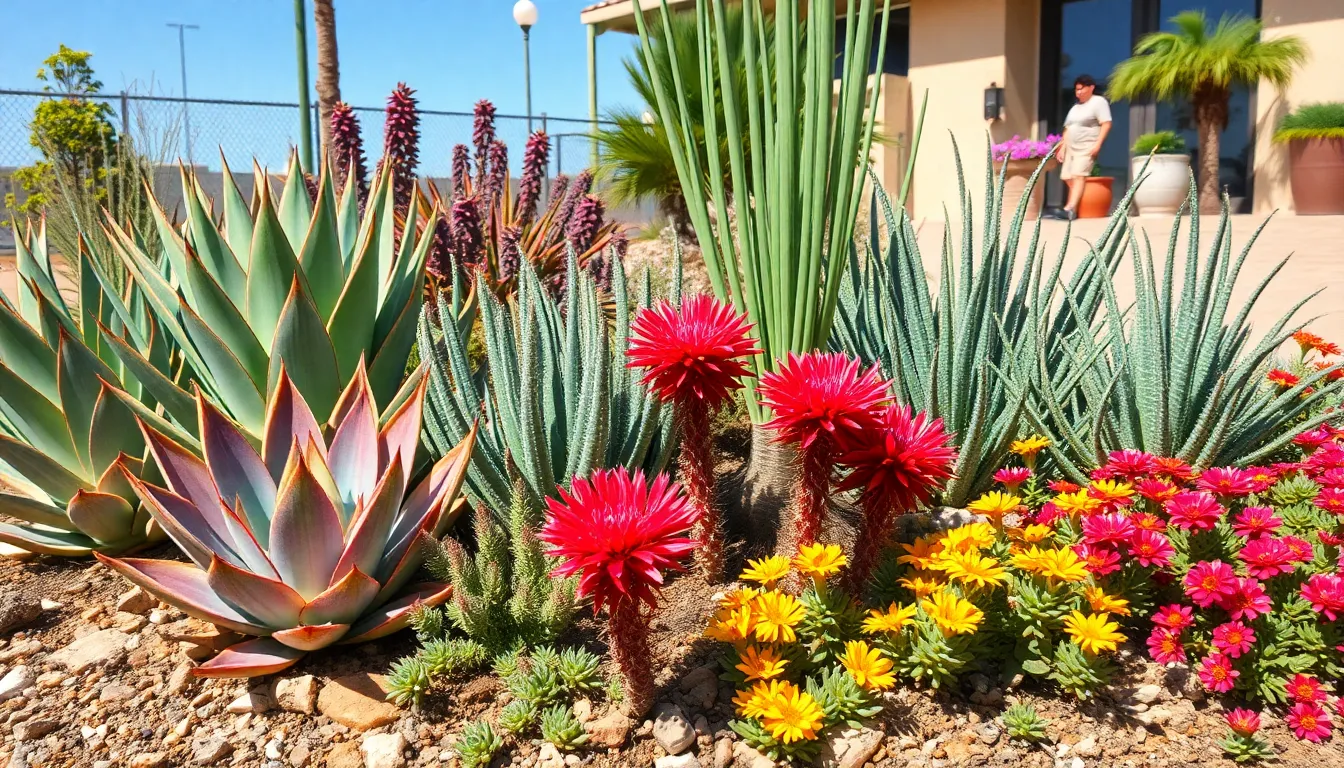
With your location established, we’ll now focus on choosing succulent varieties that’ll thrive in your exact environment while creating stunning visual displays.
Pick Drought-Tolerant Species
Agaves stand out as exceptional choices for water-conscious gardeners who want dramatic focal points in their succulent displays. These architectural plants require minimal irrigation once established and create striking silhouettes with their bold, sword-like leaves.
Yuccas offer another excellent drought-tolerant option that combines sculptural appeal with practical benefits. Their upright growth habit and needle-sharp leaves make them perfect accent plants that demand virtually no supplemental watering after the first growing season.
Echeverias provide beautiful rosette formations while maintaining impressive drought tolerance throughout hot summer months. We love how these compact succulents cluster together naturally, creating dense carpets of geometric patterns that require watering only when soil becomes completely dry.
Mix Different Textures and Colors
Fuzzy red kangaroo paw flowers introduce soft, velvety textures that contrast beautifully with smooth succulent leaves. These unique blooms add tactile interest while providing vibrant red colors that pop against green foliage backgrounds.
Mounding jade creates smooth, glossy surfaces that reflect light and add sophisticated elegance to garden compositions. Its thick, coin-shaped leaves provide a classic succulent texture that pairs wonderfully with more exotic varieties.
Colorful kalanchoes bring brilliant oranges, yellows, pinks, and reds to succulent arrangements through their cheerful flower clusters. We recommend selecting varieties in complementary colors to create cohesive palettes that change with seasonal blooming cycles.
Consider Growth Patterns and Sizes
Grouping plants with varying heights creates ever-changing visual layers that prevent monotonous flat displays. Tall specimens like tree aloes work as background anchors, while medium-height varieties fill middle spaces, and low-growing spreaders carpet foreground areas.
Cascading foliage adds sculptural dimensions that transform ordinary garden beds into living art installations. Trailing varieties like string of pearls or burro’s tail create flowing waterfalls of texture when planted on slopes or elevated areas.
Size planning prevents overcrowding issues that commonly plague succulent gardens after several growing seasons. We always research mature dimensions before planting to ensure adequate spacing for natural spreading patterns without plants competing for resources.
Design Creative Container Arrangements
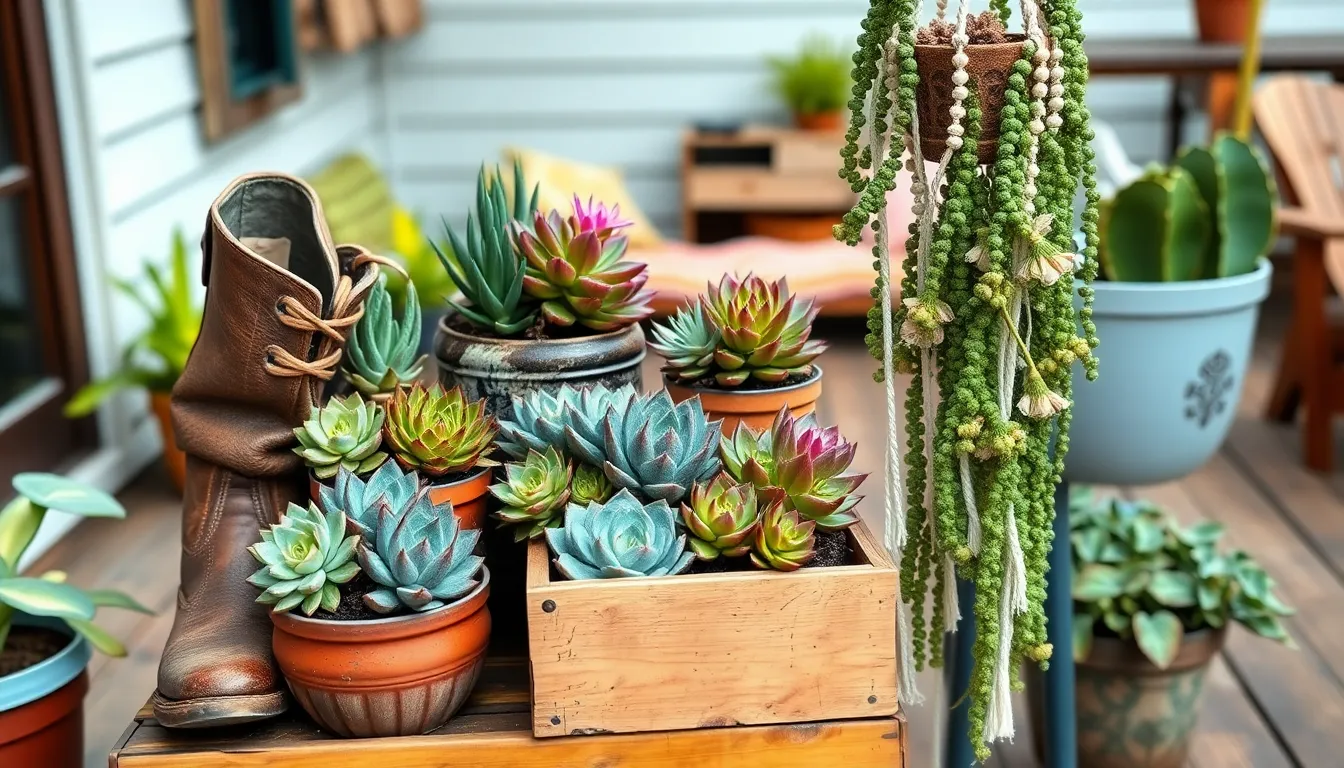
Creating unique container arrangements transforms ordinary succulent gardens into stunning displays that showcase our plants’ natural beauty. We’ll explore innovative approaches that maximize visual impact while maintaining the health of our succulent collection.
Use Vintage Containers and Repurposed Items
Vintage containers breathe character into our succulent arrangements while reducing waste from household items. Old boots become charming planters that add rustic appeal to porches and patios. Wooden crates work perfectly for grouping multiple small succulents together, creating cohesive displays with built-in organization.
Baskets offer natural texture that complements the organic shapes of our succulent varieties. We can line these containers with plastic sheeting and add drainage holes to ensure proper water management. Decorative stones and shells enhance the aesthetic appeal of these repurposed planters while providing additional drainage support around the soil surface.
Create Tiered Displays with Multiple Pots
Tiered displays maximize growing space while creating dramatic visual depth in our succulent gardens. Terracotta pots stacked in graduated sizes form natural-looking arrangements that highlight each plant’s unique characteristics. We can use tiered stands to elevate smaller specimens, ensuring every succulent receives adequate light exposure.
Varying pot sizes within our tiered arrangements allows us to showcase different growth patterns effectively. Tall, architectural succulents occupy the upper levels while compact, mounding varieties fill the lower tiers. This layering technique creates ever-changing compositions that draw the eye upward through multiple levels of texture and color.
Build Hanging Succulent Gardens
Hanging gardens maximize vertical space while showcasing cascading succulent varieties to their fullest potential. Macramé hangers provide bohemian charm while supporting our containers at ideal viewing heights. Repurposed wooden frames create structured displays that can accommodate multiple small pots within a single hanging unit.
Cascading succulents like string of pearls and donkey tail maximize visual impact in hanging arrangements. These trailing varieties create living curtains that soften hard edges and add movement to our displays. We position these hanging gardens at eye level to fully appreciate the intricate details and flowing forms of our cascading specimens.
Build a Rock Garden Paradise
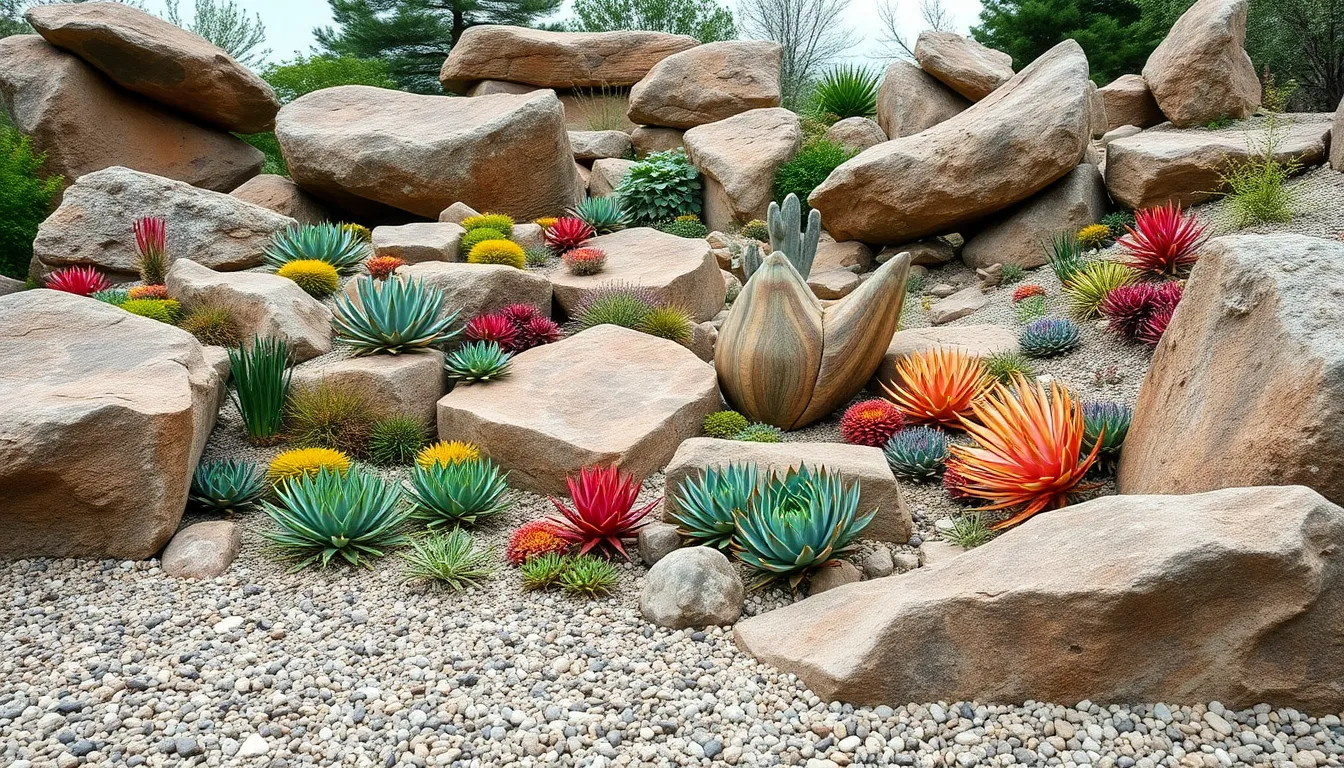
We can transform our succulent garden into a stunning rock paradise that mimics the natural desert environments where these resilient plants thrive. Building with stone elements creates both visual drama and the perfect growing conditions our succulents need to flourish.
Incorporate Natural Stone Elements
Position larger boulders or slabs as focal points to anchor our garden design and create natural-looking clusters. We’ll arrange these stone elements to form ledges and groupings that serve as backdrops for our succulent collections. Between these formations, we can group plants like agaves, sedums, echeverias, and yuccas to create repetition and striking contrast.
Select stones that complement our succulent varieties by choosing materials with colors and textures that enhance plant features. Natural limestone, sandstone, and granite provide excellent options that weather beautifully while supporting proper drainage. We’ll position these rocks to create microenvironments where different succulent species can establish their preferred growing conditions.
Use decomposed granite or pumice-amended topsoil around stone placements to ensure fast drainage and healthy root development. This combination prevents water from pooling around plant roots while maintaining the mineral-rich environment succulents prefer. Our stone elements become functional components that actively support plant health rather than just decorative features.
Create Levels with Rock Formations
Build elevated mounds using rocks to raise planting beds and improve drainage throughout our garden space. These raised areas add dimensional interest while preventing the root rot issues that plague many succulent gardens. We can sculpt berms and valleys that create natural water flow patterns during occasional rainfall.
Arrange rocks to form terraced growing areas that maximize our planting space while creating stunning visual layers. Each level provides different microclimates and viewing angles, making our garden captivating from every perspective. We’ll vary the heights to accommodate different succulent growth patterns and mature sizes.
Design natural-looking ledges where low-growing varieties like sedums and sempervivums can spill over edges and soften hard stone surfaces. These cascading plants create organic transitions between different garden levels while adding textural interest to our rock formations. Our terraced design becomes a living sculpture that evolves as plants mature and spread.
Add Gravel Pathways Between Plants
Install packed gravel walkways that provide easy access to all garden areas while reducing soil evaporation around our plants. These pathways suppress weed growth and create clean lines that define different garden zones. We can use fine crushed stone or decomposed granite for surfaces that feel natural underfoot.
Spread small pebbles as ground cover between succulent groupings to create visual breathing space and practical maintenance benefits. This mulching technique helps retain soil moisture during dry periods while allowing excess water to drain quickly after irrigation. Our gravel applications become both functional and decorative elements.
Choose pathway materials that complement our stone formations and succulent colors for cohesive garden design. Light-colored gravels reflect heat and create cooling effects, while darker materials absorb warmth for plants that prefer slightly higher temperatures. We’ll select sizes and colors that enhance rather than compete with our plant displays.
Construct Vertical Succulent Walls
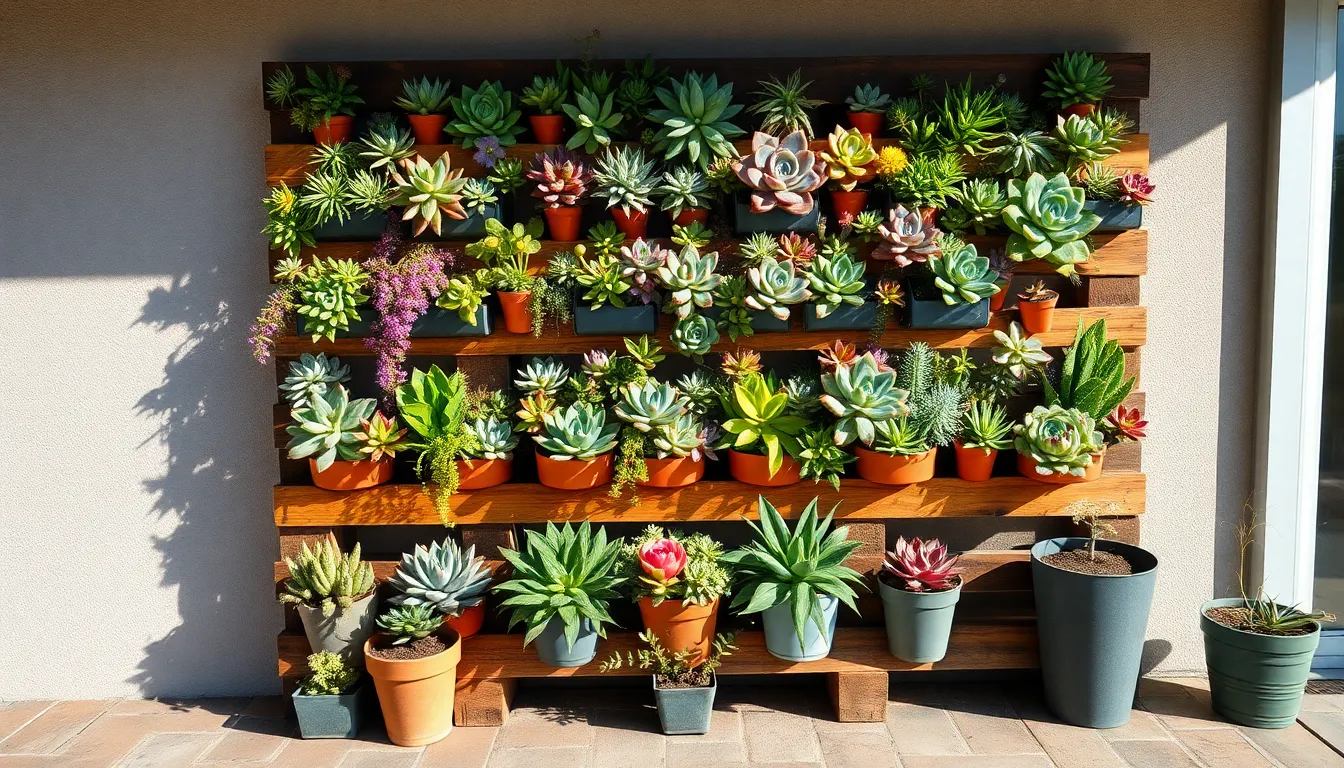
We’ve explored ground level arrangements and container displays, but now it’s time to think vertically and transform empty walls into living art installations.
Install Living Wall Systems
Installing living wall systems maximizes growing space while creating stunning visual focal points. We recommend using modular wall systems or sturdy trellises that can support the weight of multiple planters filled with soil and succulents. These systems typically include built-in irrigation channels that make watering efficient and prevent water damage to walls.
Choosing the right wall location ensures your vertical garden thrives. We suggest selecting walls that receive bright, indirect light for 4-6 hours daily, avoiding areas with intense afternoon sun that could stress the plants. South-facing walls work best in most climates, though east-facing walls provide gentler morning light that many succulents prefer.
Selecting appropriate planting modules creates optimal growing conditions. We prefer systems with individual pockets or containers that allow for proper drainage and root development. Metal grid systems with hanging planters offer flexibility, while fabric pocket systems provide excellent drainage for smaller succulent varieties.
Use Wooden Pallets for DIY Projects
Using wooden pallets creates budget-friendly vertical gardens with rustic charm. We can transform standard shipping pallets into unique succulent displays by attaching industry fabric to the back and filling the spaces with well-draining soil mix. This approach costs significantly less than commercial systems while offering complete customization options.
Preparing pallets properly ensures long-lasting installations. We recommend sanding rough surfaces and applying weather-resistant stain or sealant to prevent rot and extend the pallet’s lifespan. Heat-treated pallets marked with “HT” stamps are safest for plant use, avoiding chemically treated wood that could harm our succulents.
Arranging planters on pallets allows for creative design flexibility. We suggest attaching small terracotta pots, mason jars, or repurposed containers at varying heights to create visual interest. Mounting the pallet horizontally provides more planting surfaces, while vertical mounting creates dramatic cascading displays with trailing varieties like string of pearls.
Create Picture Frame Planters
Creating picture frame planters transforms ordinary frames into living artwork. We can repurpose vintage picture frames by removing the glass and backing, then installing wire mesh or chicken wire to hold small pots or air plants. This technique works especially well with ornate frames that add decorative elements to succulent displays.
Mounting frame planters strategically enhances wall compositions. We recommend grouping frames of different sizes to create gallery walls of living art, spacing them 12-18 inches apart for optimal visual impact. Corner installations work particularly well, utilizing often-overlooked spaces while creating conversation pieces.
Selecting appropriate succulents ensures frame planter success. We prefer compact varieties like echeveria rosettes, haworthia, and small sedums that won’t outgrow the frame dimensions quickly. Air plants eliminate soil requirements entirely, making maintenance simpler while creating ethereal floating gardens within the frames.
Develop Themed Garden Sections
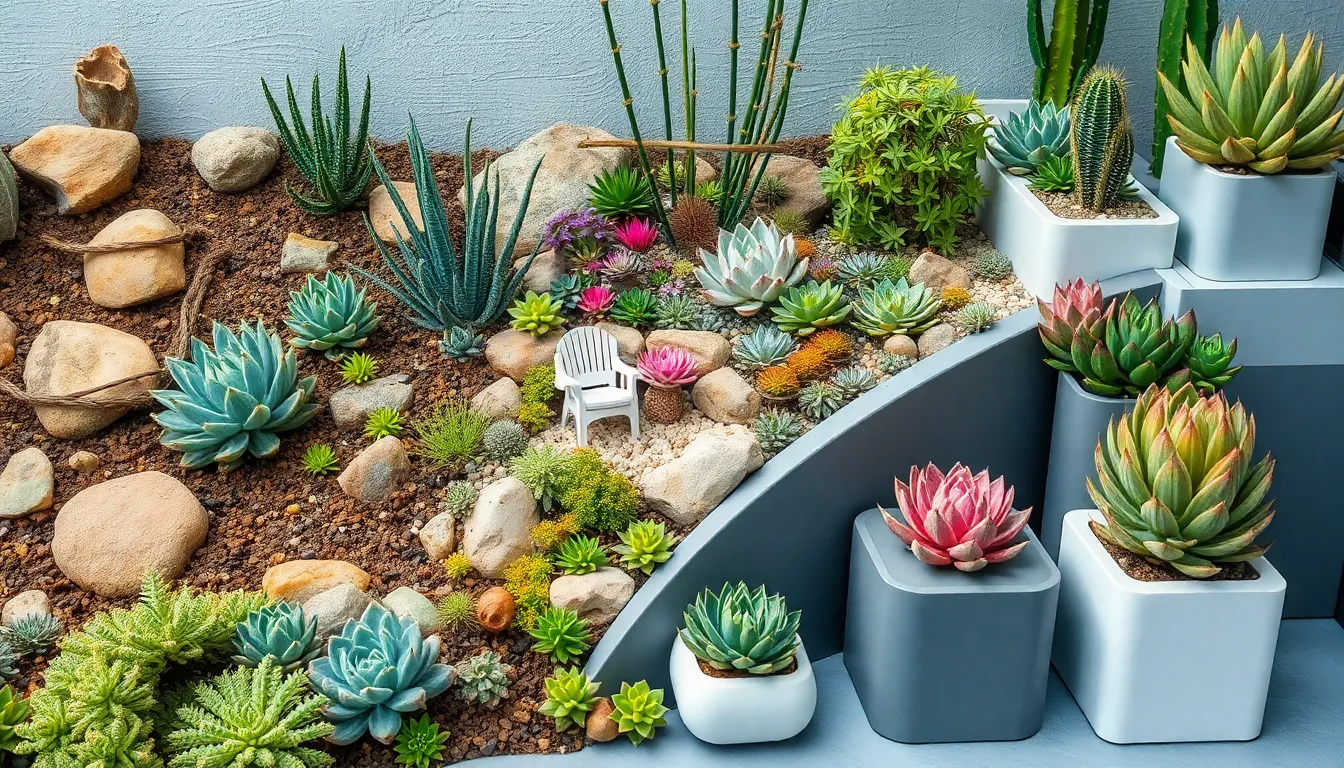
Creating cohesive themed sections transforms our succulent garden into a curated industry that tells a story and captivates visitors through intentional design choices.
Design a Desert Industry Theme
Sculpting terrain with berms and valleys creates an authentic desert atmosphere that enhances both drainage and visual appeal. We can mound soil strategically to mimic natural desert formations while providing the excellent drainage our succulents crave.
Desert adapted companions like chuparosa shrubs add height variation and attract hummingbirds to our garden space. These native plants create a natural network that supports local wildlife while complementing our succulent displays.
Repeating colors and forms establishes visual continuity throughout the desert theme. We’ll combine agaves alongside yuccas to echo dark green starburst shapes across different areas of our garden.
Natural stone elements like weathered boulders and sandstone slabs reinforce the desert aesthetic. Decomposed granite pathways connect different sections while maintaining the authentic southwestern feel we’re creating.
Create a Fairy Garden Setting
Miniature landscapes using small colorful succulents and kalanchoes transform ordinary spaces into whimsical wonderlands. We can incorporate tiny furniture, miniature sculptures, and decorative accessories to enhance the magical atmosphere.
Cascading foliage from trailing succulents creates layered effects that add depth and movement to our fairy garden sections. Plants like string of pearls or burro’s tail provide the flowing elements that make these displays enchanting.
Incorporating textures through fuzzy varieties like lamb’s ear or panda plant adds tactile interest to our miniature scenes. These soft textures contrast beautifully with the smooth surfaces of echeverias and sempervivums.
Repurposed containers like vintage teacups, old boots, or wooden crates serve as charming planters that enhance the fairy tale aesthetic. Each container becomes part of the story we’re telling through our garden design.
Build a Modern Minimalist Display
Monochromatic color schemes emphasize simplicity and elegance by focusing on succulents within a single color palette. We might choose silvery blue agaves and echeverias or stick to various shades of green for maximum impact.
Clean lines and geometric patterns maintain the minimalist aesthetic we’re pursuing. Arranging succulents in precise rows or geometric shapes creates order and sophistication in our garden design.
Architectural containers with sleek surfaces complement the modern theme perfectly. Concrete planters, metal boxes, or fiberglass containers provide the clean backdrop our minimalist display requires.
Negative space becomes as important as the planted areas in minimalist design. We’ll use gravel mulch or decomposed granite to create breathing room between plant groupings and emphasize the sculptural qualities of our chosen succulents.
Incorporate Decorative Elements and Accessories
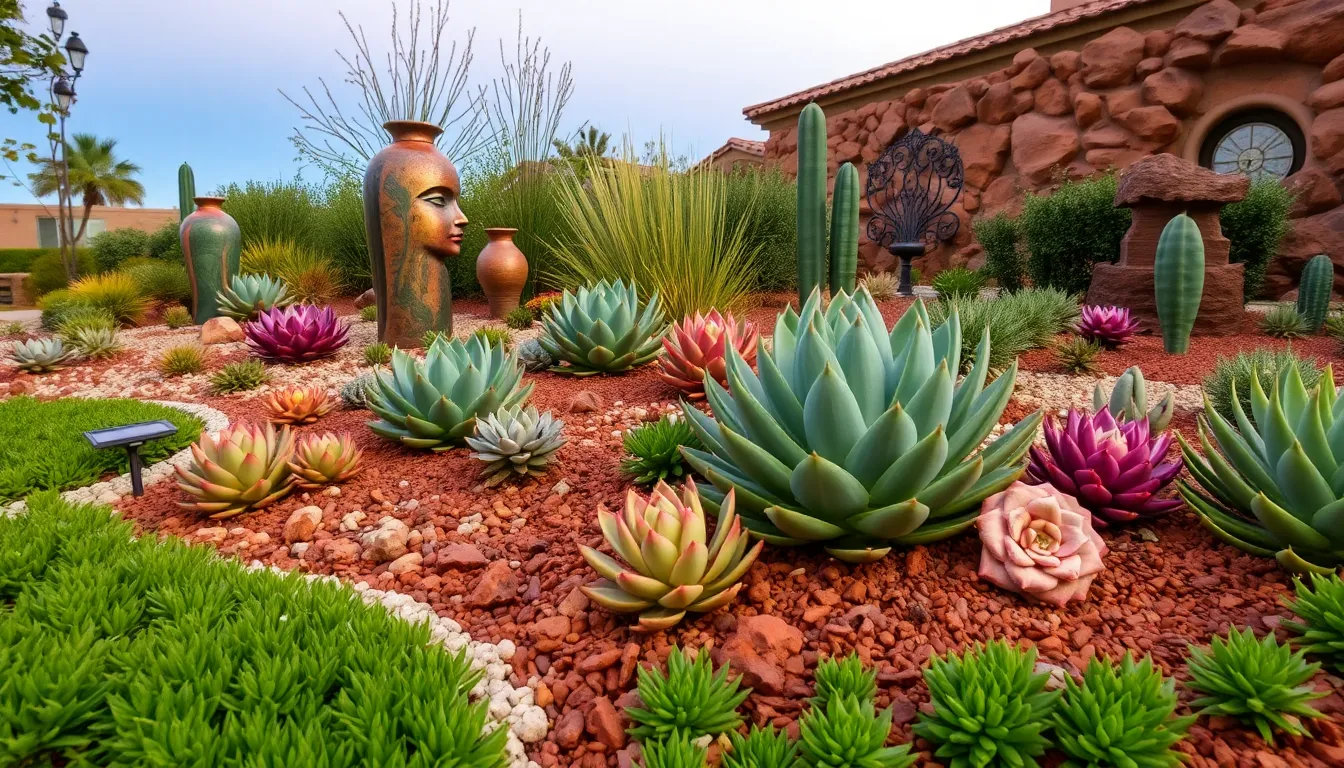
We can elevate our succulent garden’s visual appeal by thoughtfully adding decorative elements that complement the natural beauty of these resilient plants. These accessories create focal points and enhance the overall garden experience throughout the seasons.
Add Colorful Mulch and Ground Cover
Colorful mulch transforms our succulent garden into a vibrant industry that showcases each plant’s unique characteristics. Red lava rock creates a striking backdrop that makes green and blue-toned succulents pop, while colored gravel in shades of tan, gray, or burgundy adds sophisticated contrast to our plantings.
Low-growing succulents serve as living ground covers that fill gaps between larger specimens and create a cohesive garden floor. Varieties like sedum and hens-and-chicks spread naturally to form dense mats that suppress weeds while adding texture and color variation.
Strategic mulch placement helps retain soil moisture and regulate temperature around our succulent roots. Decomposed granite mixed with small pebbles provides excellent drainage while creating a clean, professional appearance that complements any garden style.
Include Garden Art and Sculptures
Garden art adds personality and artistic flair to our succulent displays while creating conversation pieces that draw visitors deeper into the space. Ceramic sculptures and mosaics, like those featured in Janet Orr’s renowned garden, introduce handcrafted elements that celebrate the intersection of nature and art.
Desert-inspired sculptures complement our succulent themes by echoing the natural environments where these plants thrive. Metal agave sculptures, stone cairns, and weathered driftwood pieces create authentic southwestern ambiance that feels both curated and organic.
We can position art pieces strategically to serve as focal points that guide the eye through different garden sections. Large ceramic pots, even when empty, function as sculptural elements that add height and visual weight to our compositions.
Install Solar Lighting Features
Solar lighting extends our garden’s beauty into evening hours while highlighting the sculptural dimension of our carefully arranged succulents. These energy-efficient fixtures require no wiring and automatically illuminate our plants’ dramatic silhouettes after dark.
Solar path lights guide visitors through our garden while emphasizing key plantings and creating safe walkways between beds. We can space these fixtures 6-8 feet apart along pathways to provide adequate illumination without overwhelming the natural nighttime ambiance.
Accent lighting focuses attention on specimen plants and architectural features that deserve special recognition. Solar spotlights positioned at the base of large agaves or barrel cacti create dramatic uplighting effects that transform our garden into an evening showcase.
Plan Seasonal Color Combinations
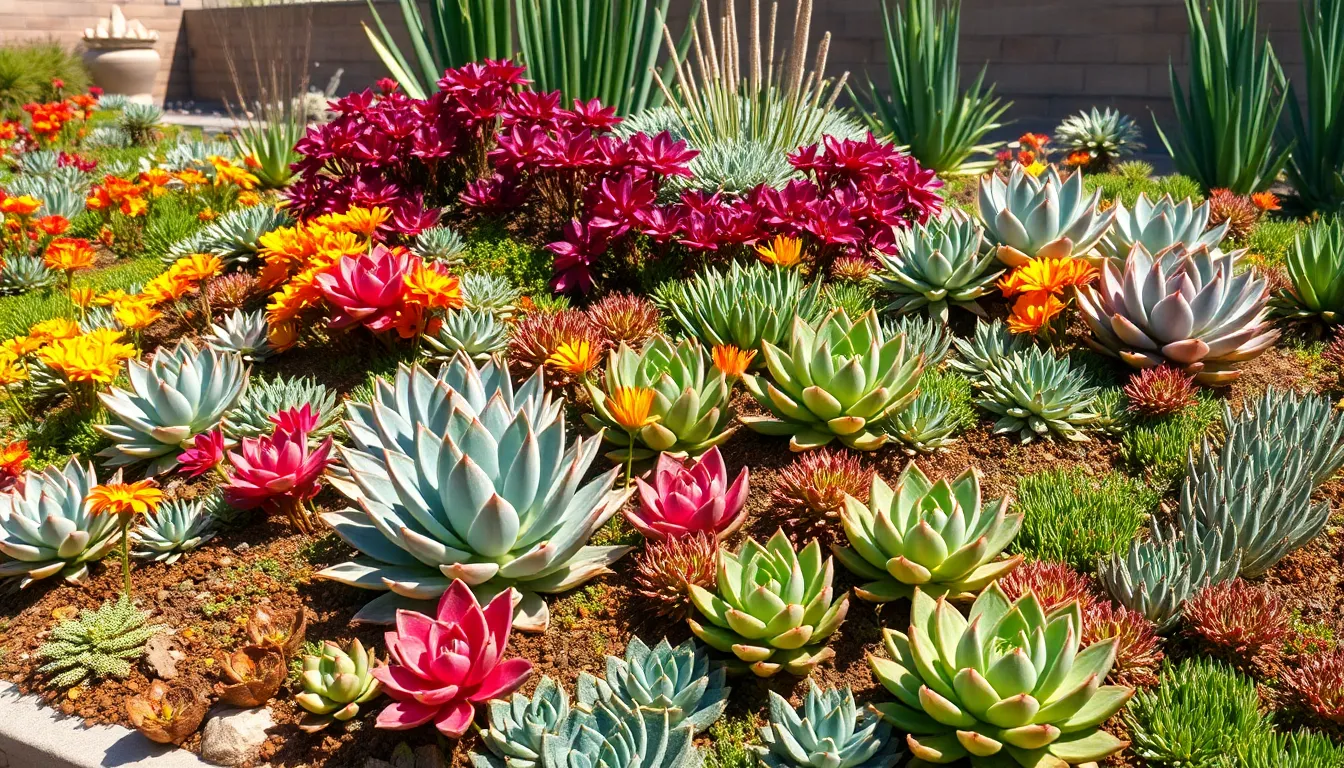
Strategic seasonal planning transforms our succulent gardens into ever-changing displays that evolve throughout the year. We can create continuous visual interest by carefully selecting plants with varying bloom times and growth patterns.
Choose Plants That Bloom at Different Times
Selecting succulents with staggered flowering seasons ensures our gardens maintain vibrant colors year round. Kalanchoes provide brilliant winter blooms in shades of orange, pink, and yellow when most other plants remain dormant. Echeverias display their coral and pink flower spikes during spring months, creating perfect transitions between seasons.
Summer brings opportunities to showcase agave flower stalks and jade plant’s delicate white clusters. Autumn blooming varieties like certain aloe species extend our color palette into cooler months with their tubular red and orange flowers. Timing becomes crucial when we plan these combinations, as overlapping bloom periods create seamless color transitions throughout our gardens.
Mix Evergreen and Seasonal Varieties
Combining evergreen succulents with seasonal flowering plants creates stable garden foundations that support changing displays. Agaves and yuccas serve as our evergreen anchors, maintaining structural presence with their architectural forms and consistent colors throughout all seasons. These drought tolerant specimens provide continuity while seasonal companions add temporary bursts of color.
Integrating seasonal additions like colorful kalanchoes against permanent succulent backdrops creates depth and visual complexity. Evergreen jade plants offer reliable green foliage that complements both spring pastels and autumn warm tones. Seasonal varieties can be swapped or repositioned as needed, while our evergreen succulents remain as consistent design elements that tie the garden together.
Create Year-Round Visual Interest
Developing multi layered displays with varying heights, textures, and bloom schedules maintains garden appeal across all seasons. Fuzzy red kangaroo paw flowers add textural contrast against smooth succulent leaves while providing seasonal color bursts. Mounding jade creates gentle transitions between taller specimens and ground level plantings.
‘Sticks on Fire’ euphorbia provides dramatic red tipped foliage that intensifies during cooler months, creating natural seasonal transitions. Sculptural elements like bermed terrain and valley formations enhance our plantings while improving drainage conditions. These design strategies work together to ensure our succulent gardens remain visually compelling whether plants are actively blooming or in their dormant phases.
Design Low-Maintenance Pathways
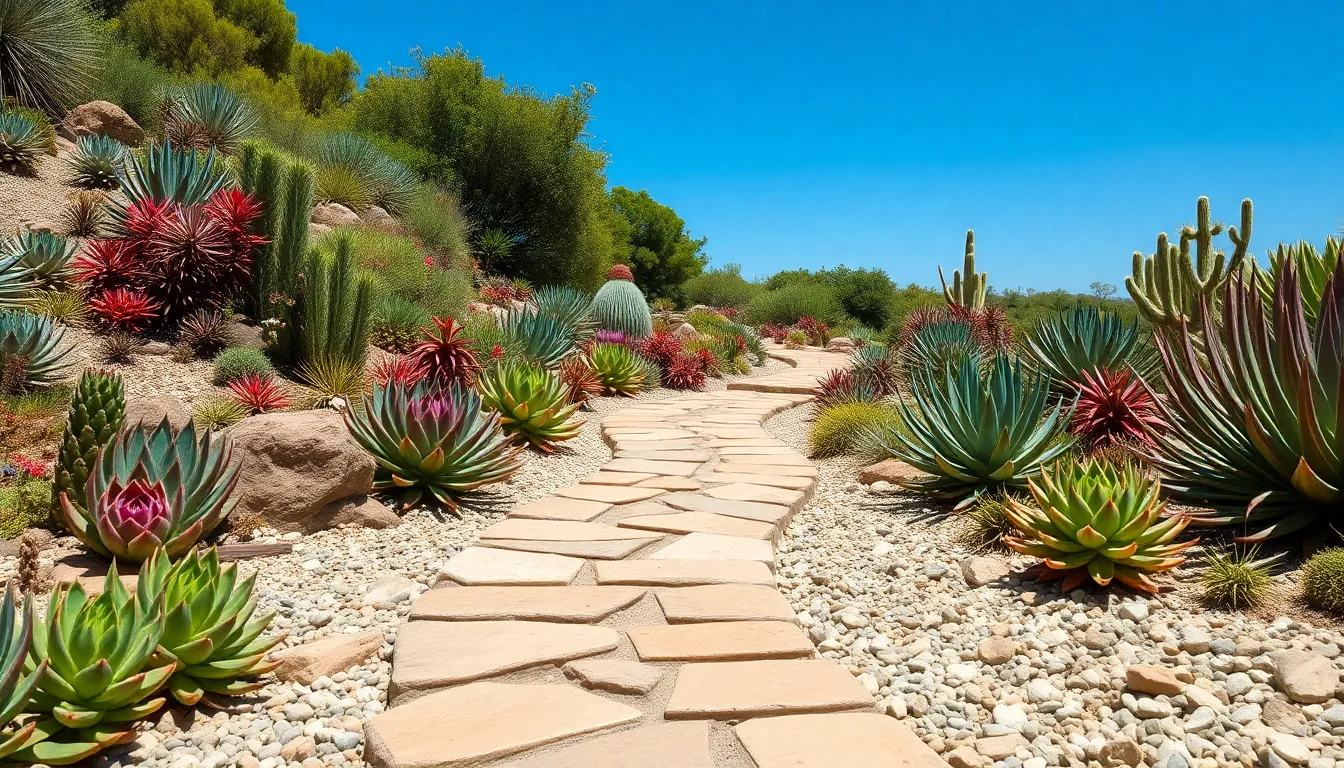
Creating functional walkways in your succulent garden doesn’t require constant upkeep when you choose the right materials. Smart pathway design enhances both accessibility and the overall aesthetic while supporting proper drainage that succulents desperately need.
Use Stepping Stones and Pavers
Stepping stones offer an elegant solution for handling through your succulent displays without disturbing the plants. We recommend spacing them 18 to 24 inches apart to create comfortable strides while allowing ample room for ground cover succulents to spread between each stone. Natural flagstone works exceptionally well because its irregular shapes create organic patterns that complement the free form growth of agaves and echeverias.
Pavers provide more structured pathways that work beautifully in geometric succulent arrangements. Choose permeable options that allow water to filter through rather than pooling on the surface. Concrete pavers with built in drainage channels prevent water from sitting around your plants’ root zones, which can lead to fatal rot issues.
Both materials allow excellent air circulation around plant bases while creating defined walking areas. Position them slightly above ground level to ensure water flows away from pathway edges toward your drought tolerant plantings where it’s needed most.
Create Crushed Stone Walkways
Crushed stone pathways bring a desert inspired aesthetic that perfectly matches the natural habitat of most succulents. We suggest using decomposed granite or small river rock in neutral tones like tan, gray, or rust to create cohesive color schemes with your plant selections. These materials compact naturally over time while maintaining excellent drainage properties.
Installation requires minimal excavation compared to solid paving materials. Simply remove 2 to 3 inches of existing soil, lay industry fabric to prevent weeds, then spread your chosen stone material evenly. The porous nature allows rainwater to penetrate directly into surrounding soil rather than creating runoff that can wash away lightweight succulent roots.
Maintenance involves occasional raking to redistribute stones and adding fresh material annually. This rustic approach complements both formal arrangements and naturalistic plantings while providing stable footing in all weather conditions.
Install Permeable Surface Materials
Permeable pavers represent the ultimate fusion of durability and drainage for succulent garden pathways. These engineered materials feature built in gaps or porous compositions that allow up to 80% of rainfall to filter through directly to the soil below. We’ve found this prevents the waterlogged conditions that kill more succulents than drought ever could.
Porous concrete offers another excellent option for larger pathway areas where you want smooth surfaces without compromising drainage. This material combines traditional concrete durability with specialized aggregates that create interconnected air pockets throughout the surface. Installation requires professional expertise but results in pathways that last decades while supporting healthy root systems.
Both materials reduce surface runoff that can erode mulch around your carefully arranged plant groupings. They also minimize pudding that attracts mosquitoes and other pests while maintaining the dry conditions that help succulents like jade plants and kangaroo paw flowers thrive in garden settings.
Establish Proper Care and Maintenance Systems
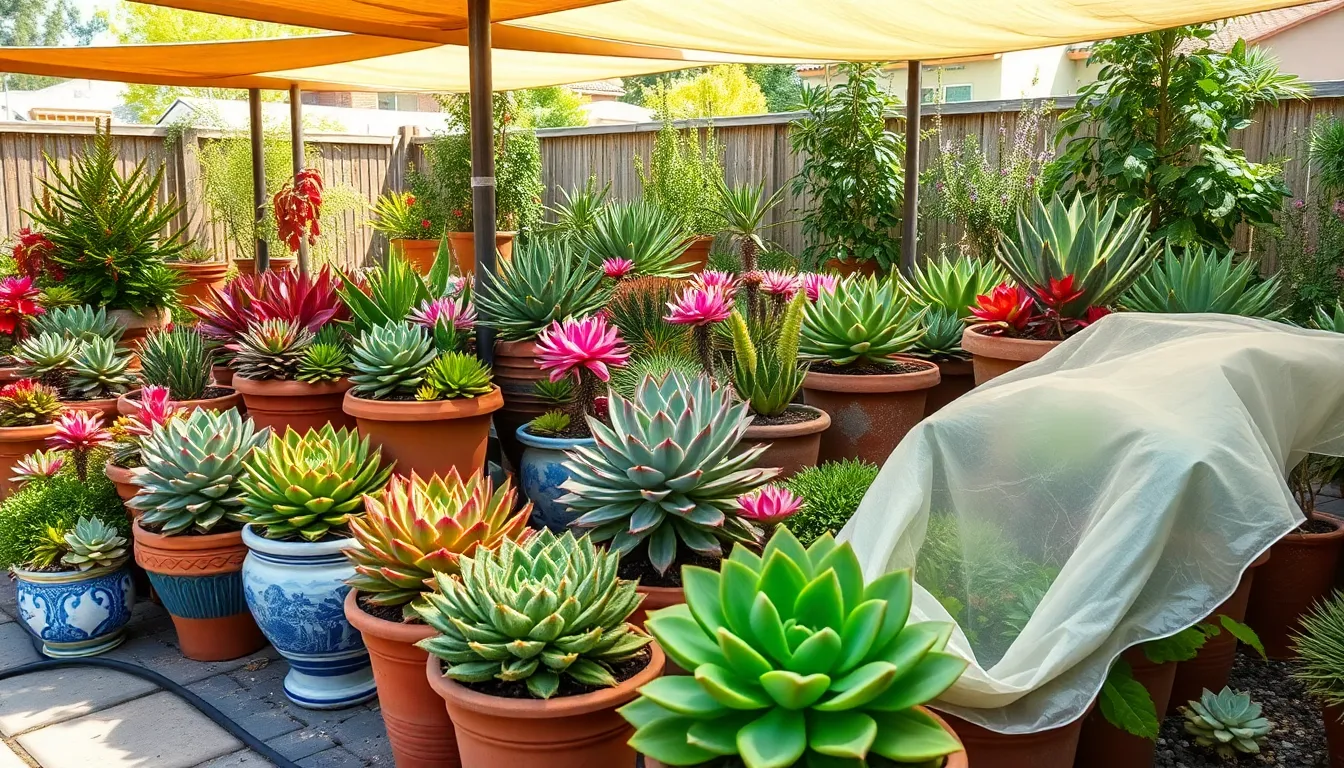
Building on our beautiful succulent displays and decorative elements, we need systematic approaches to keep our plants thriving year-round. Proper maintenance systems ensure our gardens remain stunning while minimizing daily effort.
Set Up Efficient Watering Methods
Drip irrigation systems deliver water directly to plant roots without waste or evaporation. We recommend installing soaker hoses around plant groupings to provide thorough but infrequent watering that succulents prefer. These systems prevent overwatering while ensuring each plant receives adequate moisture during dry periods.
Deep watering techniques encourage strong root development in our succulent varieties. We water thoroughly once every 10-14 days rather than frequent shallow applications that promote weak surface roots. This approach mimics natural desert rainfall patterns and helps plants develop drought resistance.
Timing our watering schedule becomes crucial for optimal plant health. We water early morning hours when temperatures are cooler and evaporation rates are lowest. Evening watering can trap moisture around plants overnight and lead to fungal issues in humid climates.
Installing water-efficient nozzles on hoses and sprinkler systems reduces water consumption while providing adequate coverage. We use adjustable spray patterns to target exact plant groupings without oversaturating surrounding areas.
Plan for Seasonal Protection
Winter protection strategies keep our outdoor succulents safe during freezing temperatures. We cover tender varieties with frost cloth or move potted specimens to protected areas like garages or covered patios. These simple steps prevent cell damage that occurs when plant tissues freeze.
Summer shade structures protect succulents from intense afternoon heat that can scorch leaves. We install shade cloth with 30-50% coverage over sensitive plants during peak summer months. This filtered light maintains healthy growth while preventing sun damage.
Monitoring temperature fluctuations helps us anticipate when protection becomes necessary. We track local weather forecasts and install thermometers in different garden microclimates to identify plants needing extra care.
Creating windbreaks shields plants from harsh seasonal winds that can dry out or damage foliage. We position larger specimens or install temporary barriers around exposed plantings during storm seasons.
Create Propagation Areas for New Plants
Leaf cutting stations allow us to multiply our favorite succulent varieties efficiently. We prepare shallow trays with well-draining soil mix where leaf cuttings can dry for several days before developing roots. This propagation method creates new plants from single leaves at minimal cost.
Seed starting setups expand our plant collection with unique varieties not available locally. We use shallow containers filled with specialized succulent soil mix to germinate seeds under controlled conditions. These designated areas maintain consistent moisture and temperature for successful germination.
Nursery spaces provide protected environments for young plants to establish before transplanting. We designate partially shaded areas where newly propagated succulents can develop strong root systems without stress from full sun exposure.
Rooting hormone applications accelerate the propagation process for challenging varieties. We apply these growth stimulants to cut surfaces before planting to encourage faster root development and higher success rates.
Conclusion
Your succulent garden journey doesn’t have to end here. We’ve covered everything from selecting the perfect varieties to creating stunning displays that’ll transform any space into a desert oasis. These versatile plants offer endless possibilities for creative expression while demanding minimal maintenance from busy gardeners.
Start small with a few containers or jump into a full industry transformation – either approach will reward you with years of natural beauty. Remember that succulent gardening is about experimentation and finding what works best in your unique environment.
We encourage you to take these ideas and make them your own. Mix different techniques create your signature style and most importantly have fun watching your succulent paradise flourish. Your neighbors will definitely take notice of your stunning new garden masterpiece.
Frequently Asked Questions
What makes succulents ideal for low-maintenance gardening?
Succulents are perfect for busy gardeners because they store water in their leaves and stems, requiring minimal watering. They’re drought-tolerant, can thrive in various light conditions, and need less frequent care than traditional plants. Most succulents only need watering every 1-2 weeks, making them ideal for beginners or those with limited gardening time.
How do I choose the right location for my succulent garden?
Select a spot with bright, indirect sunlight for 6-8 hours daily, avoiding intense afternoon sun. Ensure excellent drainage by testing soil water absorption – water should drain within 30 minutes. Consider your local climate and choose cold-hardy varieties if you experience frost, or provide protection during extreme weather conditions.
Which succulent varieties work best for beginners?
Start with hardy varieties like Echeveria, Jade plants, Sedum, and Agave. These species are forgiving, drought-tolerant, and showcase beautiful textures and colors. Mix different growth patterns – some upright, others cascading – to create visual interest. Avoid rare or finicky varieties until you gain experience with basic succulent care.
Can I create a succulent garden in containers?
Absolutely! Container gardening offers flexibility and creativity. Use vintage pots, repurposed items like wooden crates, or create tiered displays for visual depth. Ensure containers have drainage holes and use well-draining succulent soil mix. Hanging planters work excellently for cascading varieties, transforming any space into a living art installation.
How do I build a vertical succulent wall?
Install modular wall systems or sturdy trellises with built-in irrigation channels. Choose south-facing walls for optimal light exposure. DIY options include wooden pallets lined with landscape fabric or picture frame planters. Ensure proper drainage and consider weight distribution. Start small with a few planters before expanding your vertical garden.
What’s the best way to water succulents?
Use the “soak and dry” method – water deeply but infrequently, allowing soil to completely dry between waterings. Drip irrigation systems work excellently for larger gardens. Water early morning to prevent fungal issues, and avoid getting water on leaves. During winter, reduce watering frequency as plants enter dormancy.
How can I create themed sections in my succulent garden?
Develop cohesive themes like desert landscapes with berms and native plants, fairy gardens with miniature accessories, or modern minimalist designs with monochromatic color schemes. Use appropriate decorative elements, mulch colors, and plant selections that complement your chosen theme. Each section should tell a story while maintaining practical growing conditions.
What type of soil do succulents need?
Succulents require well-draining soil that prevents water retention. Use commercial succulent mix or create your own with regular potting soil, coarse sand, and perlite or pumice. The soil should drain completely within 30 minutes of watering. Avoid heavy clay soils or mixes that retain moisture, as these can cause root rot.
How do I protect succulents during different seasons?
Provide frost covers or move containers indoors during winter freezes. Create shade structures during extreme summer heat, and install windbreaks for protection from harsh winds. Monitor temperature fluctuations and adjust care accordingly. Cold-hardy varieties can remain outdoors year-round in appropriate climates, while tender species need seasonal protection.
Can I propagate my own succulents?
Yes! Most succulents propagate easily through leaf cuttings, offsets, or stem cuttings. Remove healthy leaves, let them callus for 2-3 days, then place on well-draining soil. Keep slightly moist until roots develop. Use rooting hormone to accelerate the process. Create a dedicated nursery area for young plants before transplanting to permanent locations.
